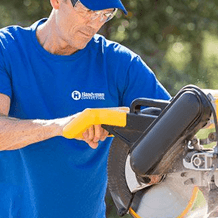Announcement
We are excited to announce that a long time Master Craftsman of our business is now the proud new owner; please join us in congratulating Earl Swader as the new owner of Handyman Connection of Blue Ash. Earl has previous business ownership already under his belt and is looking forward to continuing to serve the Blue Ash community as the proud owner.

Uncategorized / August 12, 2021
Keep Your Factory Cool During Summer with These 6 Tips

As temperatures go up in the summer months, so do the risks linked to inadequate cooling solutions at your facility. Keeping the floor cool during the hottest part of the year is crucial. This measure helps prevent machinery and equipment failure. What’s more, it can provide your workers with a comfortable and safe job environment.
Reducing heat to the necessary level with a manufacturing workspace, however, can prove to be a challenge. This is especially true when you are working toward becoming more energy-efficient (or don’t have the budget for purchasing or updating new cooling systems).
If you need help keeping your factory and your workers cool during summer, consider implementing the following best practices:
- Invest in High Volume Low Speed (HVLS) Fans
Effective airflow is instrumental to cutting down stratification. Although traditional fans can provide some relief to factory workers, bigger HVLS fans will be more effective in cooling the factory floor and breaking up blocks of hot air.
Many of these large fans are also programmable. They work in conjunction with industrial air conditioning systems and other cooling equipment to bring down the temperature.
If you want to get optimal cooling results at your facility, you’ll have to take into account a variety of factors, including the tilt of the blade, the speed at which it rotates and the size of the blade. If you are unsure which direction to go in, get in touch with an HVLS fan provider to help you find a reputable device that is right for your factory.
- Change the Color of the Factory Roof
Darker colors generally absorb more heat. Lighter colors, on the other hand, reflect the rays of the sun. If the current roof of your factor is dark, it will trap a lot of heat. You should, therefore, consider replacing it with a light-colored roof. This will keep the interior of your facility cooler and deflect more heat, ultimately helping your plant become more energy-efficient in the long term.
If roof replacement is not within your budget or too daunting of a task, don’t fret. Try applying a reflective roof coating to your current roof.
- Use LED Bulbs
If your factory is still using halogen or incandescent lighting fixtures, replace them as soon as possible by switching to LED bulbs. These bulbs waste less energy in the form of heat primarily due to their lower energy consumption for the same amount of light generated.
Switching factory lighting to LED-style fixtures will help cut down the amount of heat entering the factory and help keep the environment cooler for your workers. On top of helping keep your interior cool, LED lighting cost less to run and offer better quality lighting for production personnel.
- Install Zip Doors
As your workers move continuously throughout the factory day every day, the number of times they open doors (and consequently allow warm air in and let cold air out) can affect the flow of air and contribute to increased indoor temperatures. Although you won’t be able to control how every employee closes and opens a door, you can consider replacing these entryways with zip doors.
A zip door is a material that quickly covers a doorway to provide an airtight seal. After a factory worker opens the door, it closes automatically, quickly and securely. Some versions, in fact, may even provide verbal notifications that activate if an employee leaves a door open for too long.
Manufacturers usually make zip doors out of softer materials. This allows a door to resist damage more easily and better absorb any distress that comes its way.
- Adjust the Summer Working Hours
If your factory does not run 24 hours a day and has some flexibility in scheduling, think about changing your standard operational hours to avoid using machines or equipment during the hottest parts of the day.
One suggestion you can consider is to offer optional summer hours. This may motivate factory workers who have underlying medical problems that could make heat exhaustion or heatstroke more of a danger, as well as employees who work in the hottest parts of the factory.
Alternatively, you can move shifts to early in the morning or overnight. By making this schedule transition, your factory will experience less infiltration of heat. What’s more, employees working in the graveyard shift will benefit from a cooler work environment.
- Practice Preventive Maintenance
Conducting periodic HVAC maintenance will help your cooling system run near peak efficiency. This prevents costly breakdowns and reduces energy costs. When you maintain your HVAC equipment, recruit an outside professional or look into one of your qualified workers to routinely complete this task.
Hot, summer days can make working in a factory difficult (or sometimes unbearable) for workers. Keep your facility cool and productive all summer long by following these suggestions.




